Are you planning a trip to Vietnam and curious about the majestic temples and cultural landmarks? SIXT.VN is here to guide you through one of Southeast Asia’s most impressive religious sites. This article explores the magnificent giant bronze Buddha statue at Bai Dinh Pagoda, a key highlight of this spiritual destination. Discover its history, significance, and the profound experience it offers to visitors. Get ready to explore Ninh Binh’s famous Buddhist pilgrimage site! We also provide booking and transport assistance.
1. Discovering Bai Dinh Pagoda: A Spiritual Journey
The giant bronze Buddha statue at Bai Dinh Pagoda is a major attraction, symbolizing peace and enlightenment. The Bai Dinh Pagoda is a sprawling complex of Buddhist temples located in the Ninh Binh Province of Vietnam, a place steeped in history and spiritual significance. Nestled amidst the stunning landscapes of Bai Dinh Mountain, this complex is not just a religious site but also a cultural landmark attracting tourists and pilgrims alike.
1.1. Historical Significance of Bai Dinh
Bai Dinh Pagoda holds a special place in Vietnamese history, dating back over 1,000 years. According to historical records, three feudal dynasties, namely Dinh, pre-Le, and Ly, ruled in Ninh Binh. These dynasties were deeply influenced by Buddhism, which they considered the national religion. As a result, they constructed numerous pagodas, including Bai Dinh Pagoda, to promote and practice Buddhism. The name Bai Dinh translates to “worshipping at the top of the mountain,” indicating its importance as a sacred place for religious ceremonies.
1.2. Bai Dinh Pagoda: A Modern Marvel
The Bai Dinh Pagoda complex is divided into two main sections: the original ancient temple and the newly constructed larger temple. The new temple was built to accommodate the increasing number of pilgrims and tourists visiting the site. The complex is renowned as the largest Buddhist temple complex in Vietnam, drawing visitors from all over the country and the world.
1.3. Unique Attractions Within the Complex
Bai Dinh Pagoda boasts several unique attractions that make it a must-visit destination. These include:
- 500 Arhat Statue Corridor: A long corridor featuring 500 intricately carved Arhat statues, each with a unique expression and posture.
- Massive Shakyamuni Buddha Statue: One of the largest bronze Buddha statues in Southeast Asia, symbolizing enlightenment and peace.
- Thousand-Armed and -Eyed Mother of Compassion Statue: A stunning depiction of Quan Am, the Goddess of Compassion, with a thousand arms and eyes, representing her ability to see and help all beings.
- Biggest Bell-Tower in Southeast Asia: A towering bell-tower housing a massive bronze bell, considered the largest in Vietnam.
2. Unveiling the Giant Bronze Buddha Statue
What Is The Giant Bronze Buddha Statue At Bai Dinh? The giant bronze Buddha statue at Bai Dinh Pagoda is a monumental depiction of the Shakyamuni Buddha, symbolizing enlightenment and peace. It is one of the most prominent features of the complex and a major draw for visitors.
2.1. Size and Dimensions
The Shakyamuni Buddha statue stands at an impressive height of 10 meters (approximately 33 feet) and weighs 100 tons. These dimensions make it one of the largest bronze Buddha statues in Asia, a testament to the craftsmanship and dedication involved in its creation.
2.2. Material and Craftsmanship
The statue is made of bronze, a durable and valuable material that has been used for centuries in the creation of religious icons. According to artisans, the statue is inlaid with wine, enhancing its aesthetic appeal and spiritual significance. The intricate details and smooth finish reflect the skill and artistry of the Vietnamese craftsmen who created it.
2.3. Location within the Complex
The giant Buddha statue is housed in the Shakyamuni Buddha Main Hall, a grand structure within the Bai Dinh Pagoda complex. The main hall is approximately 34 meters (112 feet) high and 2000 square meters (21,500 square feet) wide, providing a spacious and reverent setting for the statue.
2.4. Significance of Shakyamuni Buddha
Shakyamuni Buddha, also known as Siddhartha Gautama, is the founder of Buddhism. He is revered as the Supreme Buddha who discovered the path to enlightenment and taught it to others. The statue of Shakyamuni Buddha at Bai Dinh Pagoda symbolizes the Buddha’s teachings on peace, compassion, and wisdom.
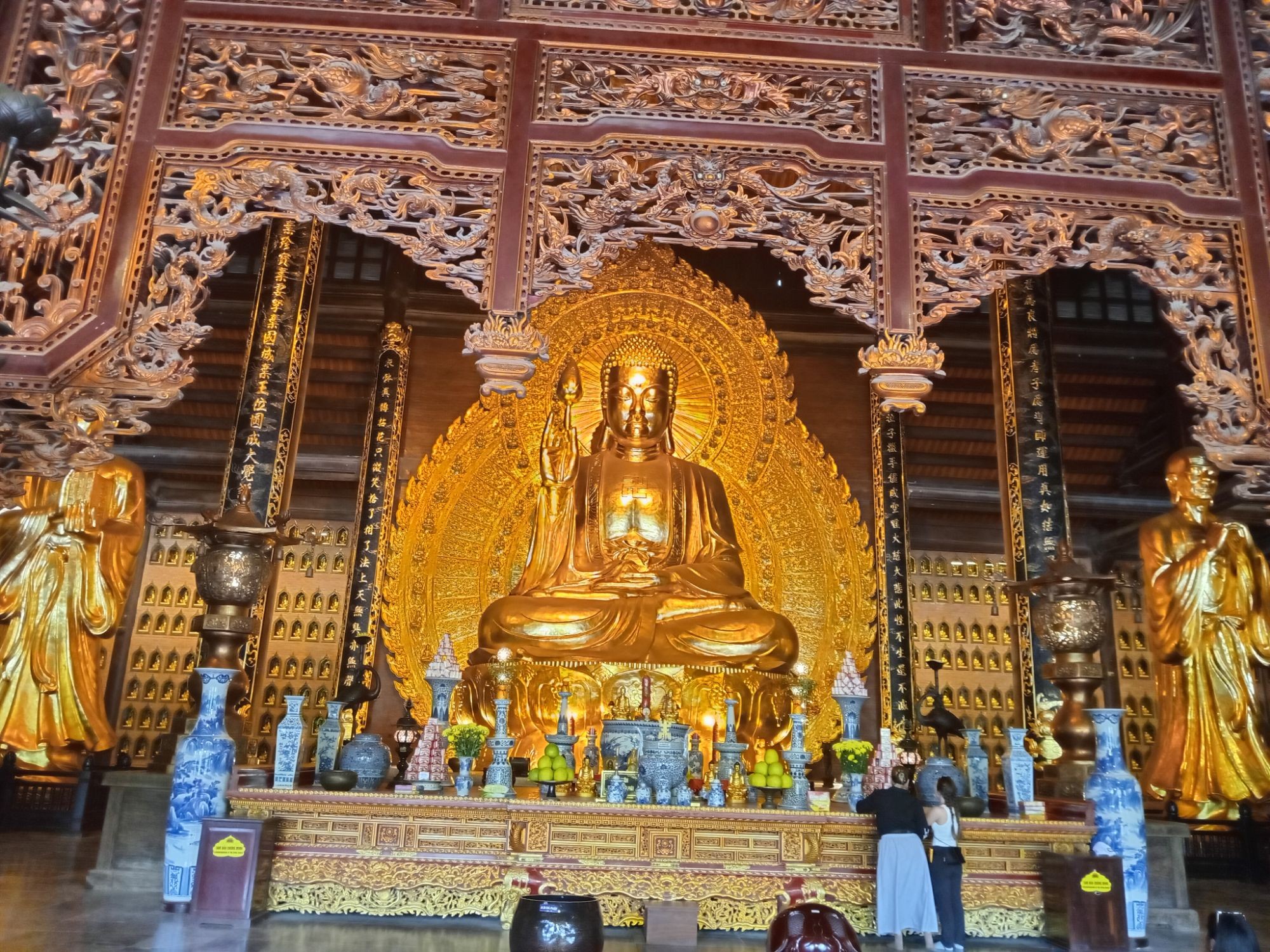 Shakyamuni Buddha Statue, Bai Dinh complex. Photo: Adele Tomlin (November 2024)
Shakyamuni Buddha Statue, Bai Dinh complex. Photo: Adele Tomlin (November 2024)
2.5. Cultural and Religious Significance
The giant Buddha statue holds immense cultural and religious significance for Vietnamese Buddhists. It serves as a focal point for worship and meditation, inspiring devotees to follow the Buddha’s teachings and strive for enlightenment. The statue also represents the rich Buddhist heritage of Vietnam and the country’s long-standing tradition of religious tolerance and harmony.
2.6. Symbolism
In Buddhist culture, the bronze material symbolizes durability, strength, and longevity. The statue’s craftsmanship ensures its preservation for future generations and embodies the enduring teachings of the Buddha. The seated posture of the Shakyamuni Buddha represents meditation, stability, and inner peace, encouraging visitors to find these qualities within themselves.
2.7. Spiritual Impact
The statue serves as a profound reminder of Buddha’s teachings. Seeing such a grand representation of Buddha, one can better grasp the path to enlightenment, encouraging a spiritual journey. Worshippers often meditate near the statue, seeking guidance.
3. Exploring the Bai Dinh Pagoda Complex
The Bai Dinh Pagoda complex offers a wide range of attractions and activities for visitors to explore. Here are some of the key highlights:
3.1. The 500 Arhat Statues Corridor
What is the giant bronze Buddha statue at Bai Dinh without its surroundings? The 500 Arhat Statues Corridor is one of the most striking features of the Bai Dinh Pagoda complex. This corridor stretches for approximately 3 kilometers (1.9 miles) and features 500 intricately carved Arhat statues, each with a unique facial expression and posture.
3.1.1. Construction and Design
The corridor is constructed entirely of wood, using about 3,500 cubic meters of round wood. Along the left and right sides of the corridor, the 500 Arhat statues stand as silent guardians, each about 2.5 meters (8.2 feet) high and weighing about 4 tons.
3.1.2. Craftsmanship
The statues are made of stone and crafted by artisans from Ninh Van stone village in Hoa Lu. Each statue has a unique facial expression and posture, conveying philosophical ideas about human emotions.
3.1.3. Spiritual Experience
Walking through the corridor is a spiritual experience, allowing visitors to contemplate the diversity of human nature and the path to enlightenment. The corridor is also known as Arhat Duong or Arhat Road. It consists of two rows, each with 117 compartments, stretching 1700 meters (1.1 miles) long, setting a record as the longest Arhat corridor in Asia.
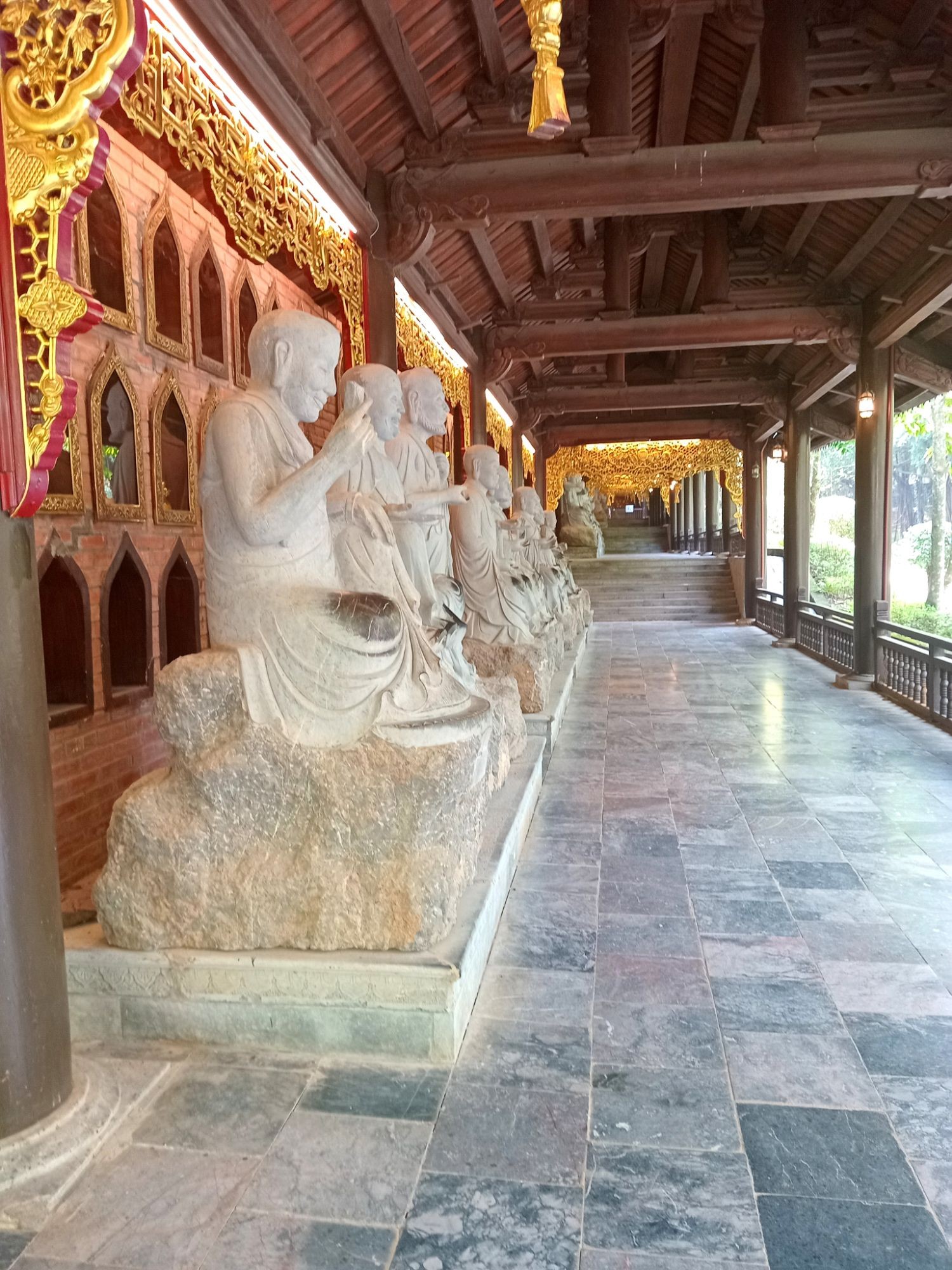 The stunning 500 Arhat Statues corridor at Bai Dinh complex. Photo: Adele Tomlin (November 2024)
The stunning 500 Arhat Statues corridor at Bai Dinh complex. Photo: Adele Tomlin (November 2024)
3.2. The Bell Tower
The Bell Tower is another notable structure within the Bai Dinh Pagoda complex. It stands at a height of 18.25 meters (60 feet) and has a diameter of 17 meters (56 feet), built in the architectural style of an ancient three-story octagonal bell tower with 24 roofs, shaped like a giant stylized lotus flower.
3.2.1. The Giant Bell
Hanging in the steeple is a 36-ton bell cast by artisans from Hue. In 2007, the bell was certified by the Vietnam Record Book Center as the largest Dai Hong Chung in Vietnam.
3.2.2. Ringing the Bell
To ring this bell, an ironwood tree must be used as a bell stick, weighing 5 quintals (about 1100 pounds), 4.5 meters (15 feet) long, and 0.32 meters (1 foot) in diameter.
3.2.3. The Bronze Drum
Below the bell is a bronze drum, a replica of the Dong Son bronze drum. The diameter of the drum’s surface is 5.5 meters (18 feet), and it weighs 70 tons, cast by artisans from Kien Xuong district, Thai Binh province.
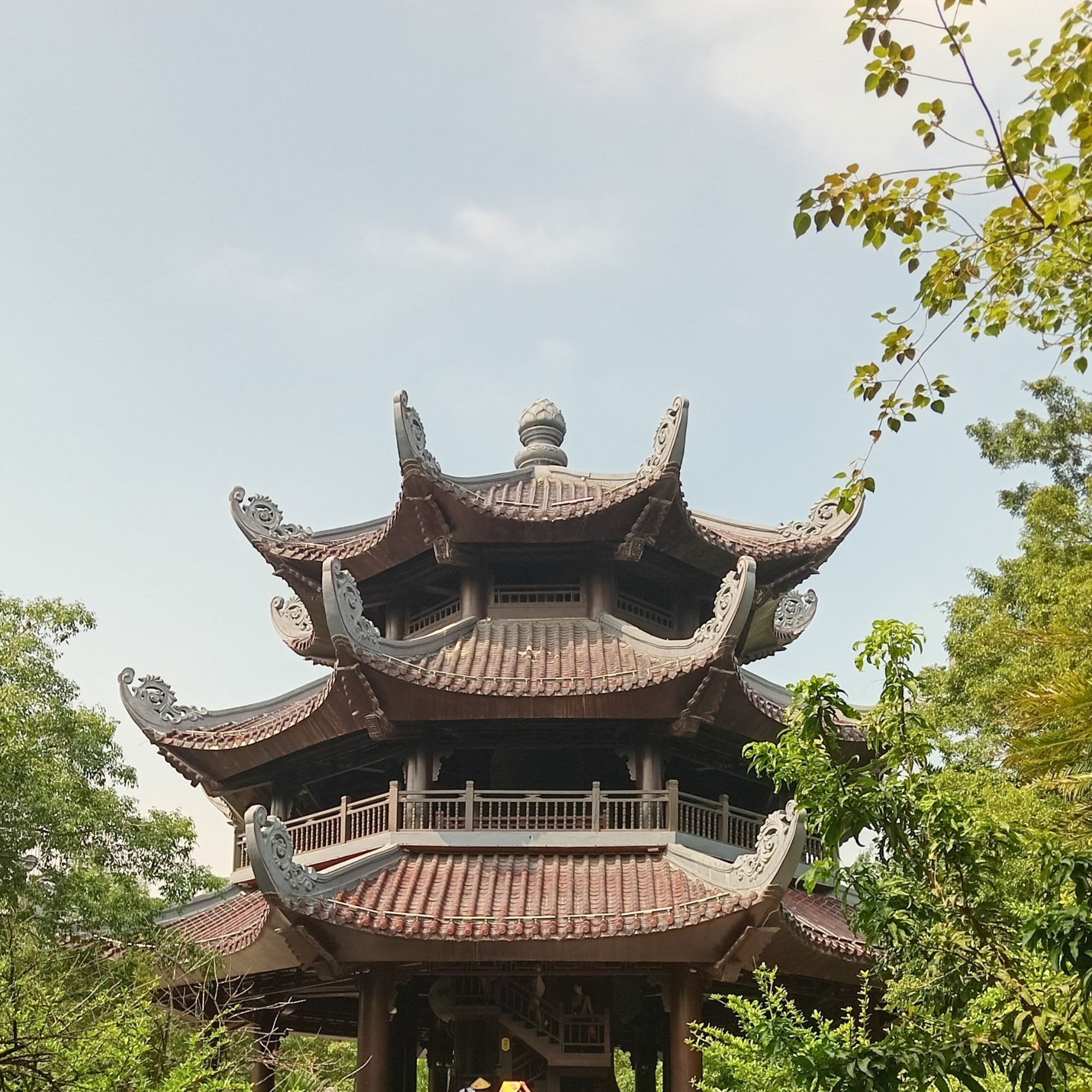 Bell-tower at Bai Dinh complex. Photo: Adele Tomlin (November 2024)
Bell-tower at Bai Dinh complex. Photo: Adele Tomlin (November 2024)
3.3. The Mother of Compassion (Quan Am) Palace
The Mother of Compassion (Quan Am) Palace is another stunning main hall within the Bai Dinh complex. The architecture is made entirely of wood, using 900 cubic meters of wooden blocks. The main hall is about 14 meters (46 feet) high and 16 meters (52 feet) wide.
3.3.1. The Thousand-Armed and -Eyed Statue
In the center of the main hall is a statue certified by the Vietnam Record Book Center as the largest bronze statue of Quan The Am in Vietnam. The statue is about 10 meters (33 feet) high and weighs 90 tons, made of copper inlaid with gold.
3.3.2. The Legend of Quan Am
The statue represents Quan Am Thien Thu Thien Nhan (Quan Yin with a thousand hands and thousand eyes). According to legend, she was the daughter of King Dieu Trang Vuong, who sacrificed her hands and eyes to cure her father’s illness. The Buddha gave her a thousand eyes and a thousand hands so that she could do more public works and understand the sufferings of sentient beings.
3.3.3. Symbolism
The statue of Guanyin here is shown with three overlapping faces, representing the three religions: Confucianism, Taoism, and Buddhism. The statue has five pairs of large hands, each hand showing a different seal, symbolizing compassion.
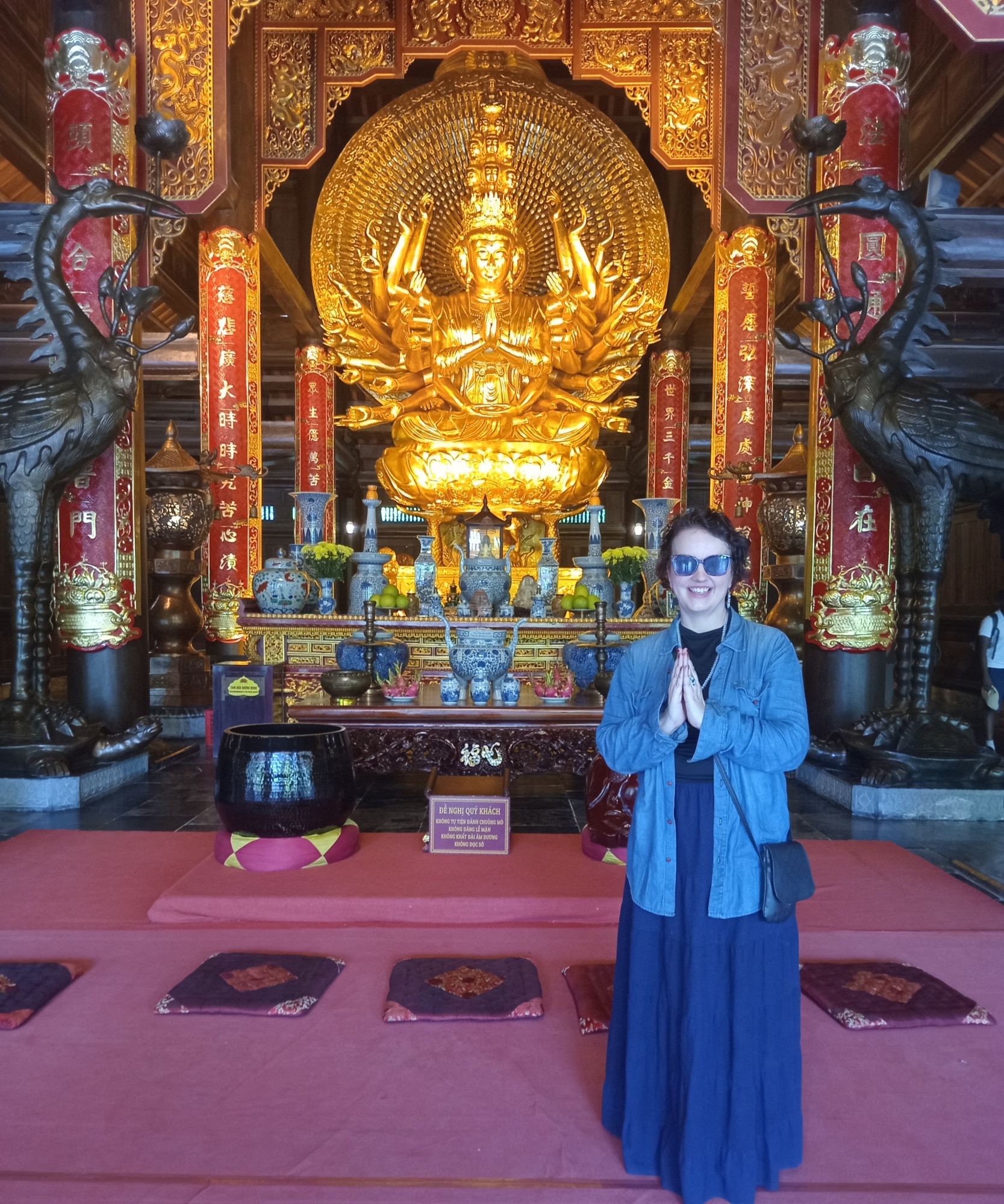 Thousand-armed and thousand-eyed Mother of Compassion statue at the Bai Dinh complex. Photo: Adele Tomlin (November 2024)
Thousand-armed and thousand-eyed Mother of Compassion statue at the Bai Dinh complex. Photo: Adele Tomlin (November 2024)
3.4. The Buddha Shakyamuni Temple
The Buddha Shakyamuni Temple is another significant site within the complex. With a height of about 34 meters (112 feet) and a width of about 2000 square meters (21,500 square feet), the main hall houses the statue of Shakyamuni Buddha in the middle, standing 10 meters (33 feet) tall and weighing 100 tons.
3.4.1. Bronze Statues
Made of bronze inlaid with wine, the pagoda has set a record for having the largest bronze statue of Buddha Shakyamuni in Asia.
3.4.2. Disciples and Guardians
In addition to the Buddha image, you see his two disciples on either side: Ananda holding the Buddhist Tripitaka and Mahakassapa. They are made of bronze and inlaid with gold, about 7.2 meters (24 feet) high and weighing 30 tons. On the two sides of the main hall, there are eight upper phoenixes, diamond bowls placed to worship and protect Buddhist scriptures and teachings.
3.4.3. Intricate Details
Looking around the main hall, there are 1616 square blocks with 1616 small Buddha statues inside.
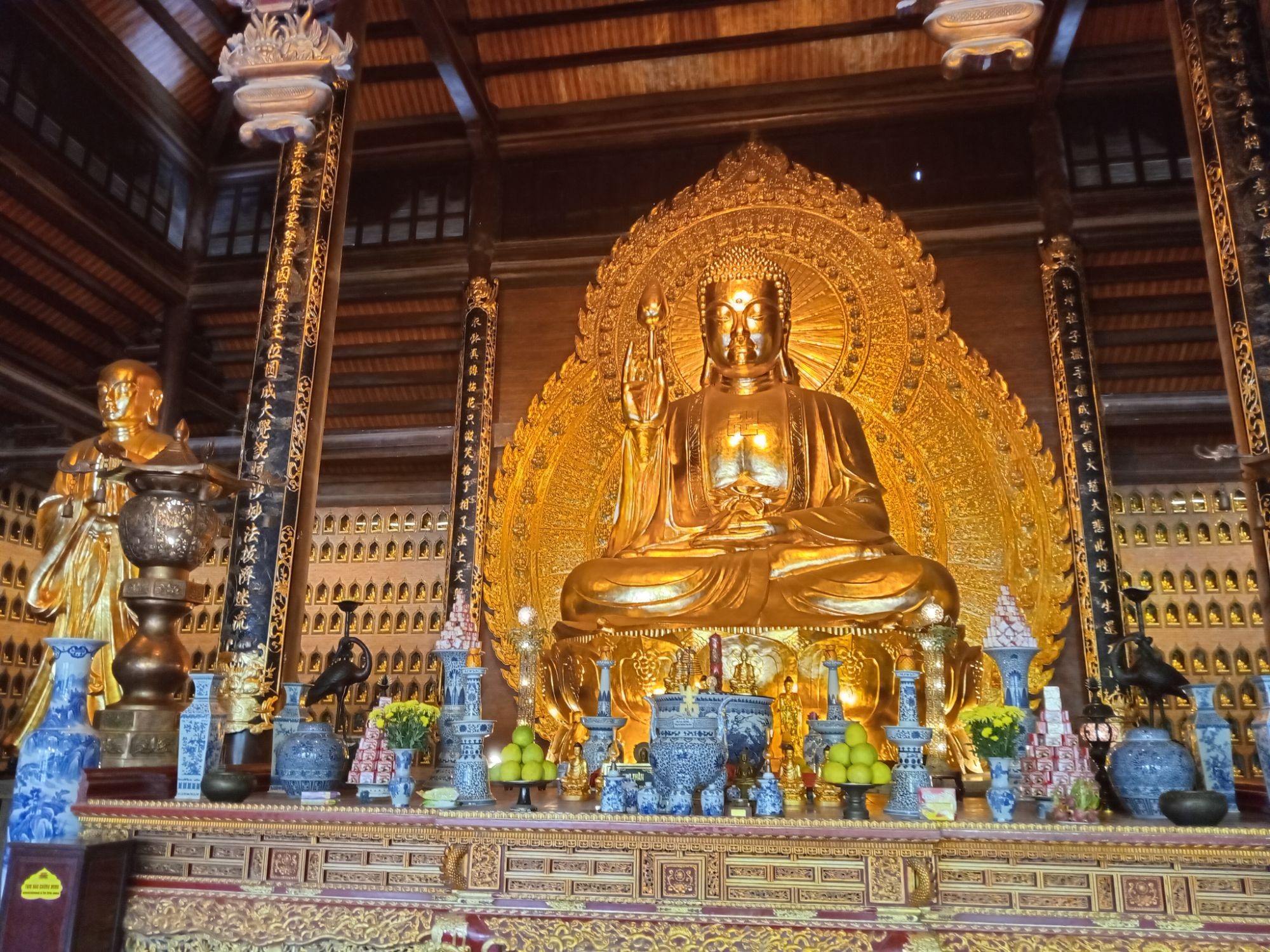 Buddha Shakyamuni Statue, Bai Dinh complex. Photo: Adele Tomlin (November 2024)
Buddha Shakyamuni Statue, Bai Dinh complex. Photo: Adele Tomlin (November 2024)
4. Planning Your Visit to Bai Dinh
Visiting Bai Dinh Pagoda requires some planning to ensure a smooth and enriching experience. Here’s how SIXT.VN can help:
4.1. Getting There
Ninh Binh is easily accessible from Hanoi. You can travel by road, bus (the most economical option), or train, all of which take approximately 2.5 hours.
4.2. Transportation Options
SIXT.VN offers various transportation options to suit your needs and preferences:
- Private Car: Enjoy a comfortable and convenient ride with our private car service.
- Shuttle Bus: Opt for a cost-effective shuttle bus service, perfect for solo travelers or small groups.
- Train: We can assist with booking train tickets for a scenic and relaxing journey.
4.3. Organized Day Trips
Consider booking an organized day trip for a hassle-free experience. SIXT.VN partners with reputable tour operators to provide comprehensive tours that include transportation, meals, and guided tours of Bai Dinh Pagoda and surrounding attractions.
4.4. Accommodation
SIXT.VN offers a wide range of accommodation options in Ninh Binh, from budget-friendly guesthouses to luxurious hotels. We can help you find the perfect place to stay based on your preferences and budget.
4.5. Booking Tickets
Avoid long queues and ensure entry by booking your tickets in advance through SIXT.VN. We provide a seamless booking process, allowing you to focus on enjoying your visit.
4.6. Best Time to Visit
The best time to visit Bai Dinh Pagoda is during the dry season, from November to April, when the weather is pleasant and ideal for outdoor activities. However, be prepared for larger crowds during peak tourist season.
4.7. What to Wear
As a religious site, it is important to dress respectfully when visiting Bai Dinh Pagoda. Opt for modest clothing that covers your shoulders and knees. Comfortable shoes are also recommended, as you will be doing a lot of walking.
4.8. Etiquette
Respectful behavior is essential when visiting any religious site. Here are some guidelines to follow:
- Remove your shoes before entering temples and prayer halls.
- Speak quietly and avoid loud conversations.
- Do not touch or climb on statues and sacred objects.
- Seek permission before taking photographs of monks or worshippers.
- Refrain from public displays of affection.
5. Enhancing Your Trip with SIXT.VN Services
SIXT.VN offers a range of services to enhance your trip to Bai Dinh Pagoda and Ninh Binh:
5.1. Tailored Travel Packages
We create customized travel packages to suit your interests and preferences, ensuring a unique and memorable experience.
5.2. Airport Transfer Services
Enjoy a smooth and stress-free arrival and departure with our reliable airport transfer services. Our professional drivers will meet you at the airport and transport you to your hotel in Ninh Binh.
5.3. Hotel Booking
Choose from a wide selection of hotels in Ninh Binh, ranging from budget-friendly options to luxurious resorts. We offer competitive rates and exclusive deals to help you save on accommodation.
5.4. Tour and Activity Bookings
Discover the best of Ninh Binh with our curated selection of tours and activities. From boat trips to ancient temples, we offer something for everyone.
5.5. Flight Booking Assistance
Let us handle your flight bookings, ensuring you get the best deals and a seamless travel experience.
6. Experiencing Trang An and Mua Cave
While visiting Bai Dinh, consider exploring the nearby attractions of Trang An and Mua Cave.
6.1. Trang An Boat Trip
Take a two-hour sampan boat trip around the UNESCO world heritage landscape of Trang An. The area features limestone karst peaks permeated with valleys, many of them partly submerged and surrounded by steep cliffs.
6.1.1. Historical Significance
Exploration of caves has revealed archaeological traces of human activity over 30,000 years, illustrating the occupation of these mountains by seasonal hunter-gatherers. Hoa Lu, the ancient capital of Vietnam, was strategically established here in the 10th and 11th centuries AD.
6.1.2. Natural Beauty
The dramatic mountains, secretive caves, and sacred places in Trang An have inspired people through countless generations.
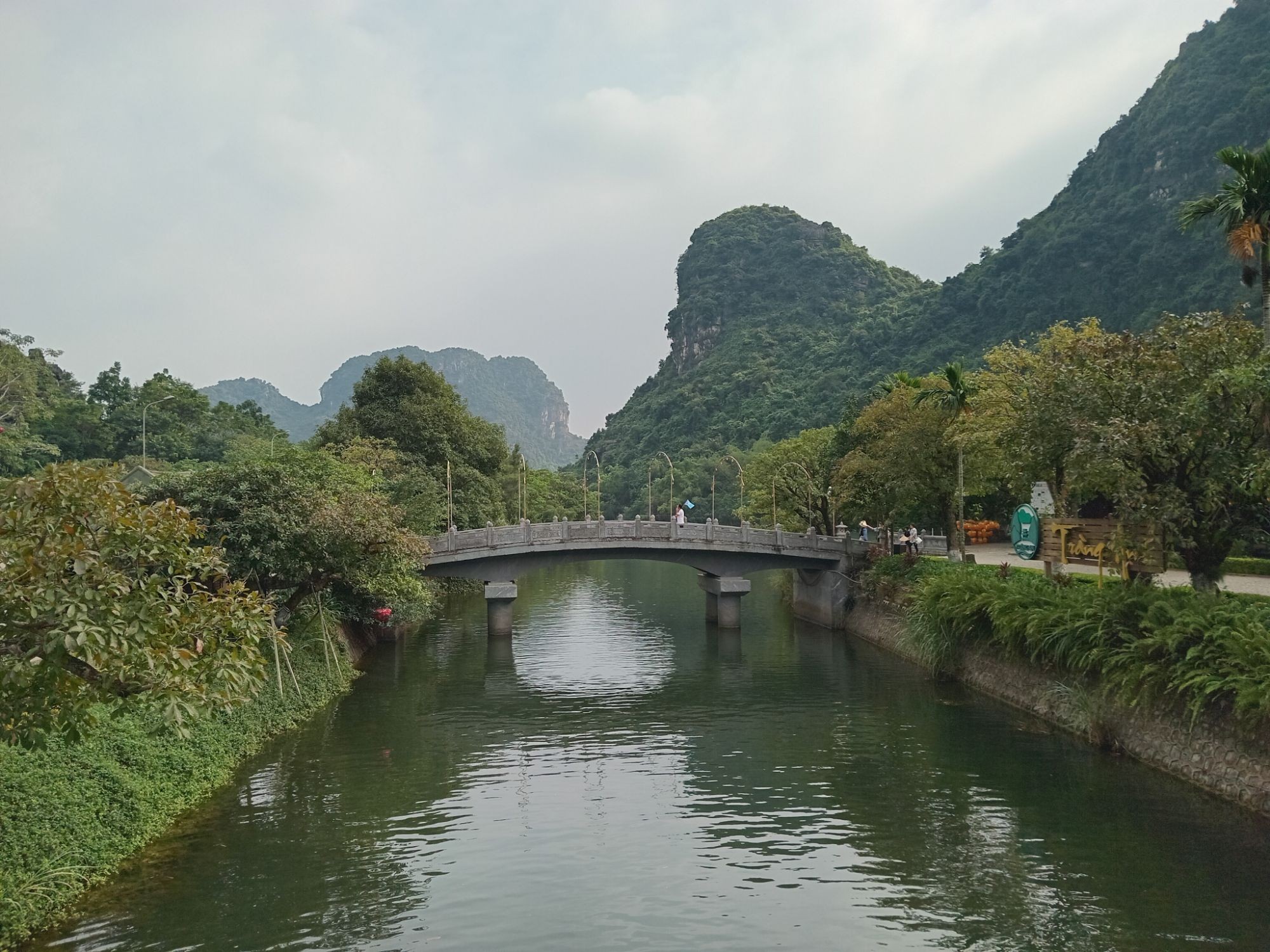 Starting the two hour boat trip around Trang An. Photo: Adele Tomlin (November 2024).
Starting the two hour boat trip around Trang An. Photo: Adele Tomlin (November 2024).
6.2. Mua Cave Mountain Peak
Visit Mua Cave for one of the best panoramic views of Ninh Binh. Climb 486 stone steps to see beautiful sceneries on the top of Mua mountain.
6.2.1. Lotus Lake
Located on the right-hand side of the entrance is a valley of colorful flowers and a large lotus lake. If you visit in the summer, you will have the opportunity to take photos and enjoy the lotus.
6.2.2. Panoramic Views
The road to Mua Cave is imitated as the Great Wall of China, offering stunning views along the way.
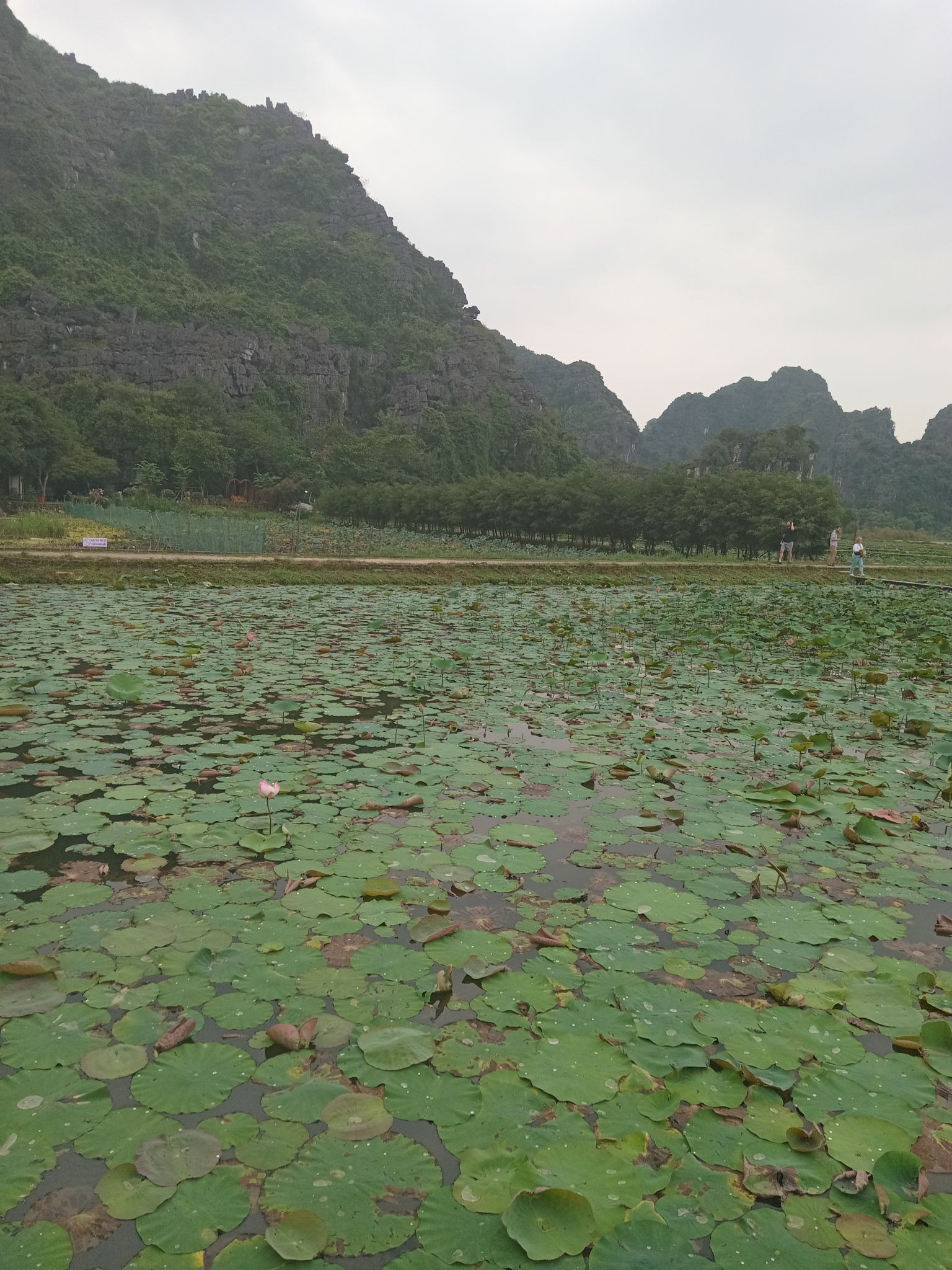 Lotus Lake below the Mua Cave Mountain. Photo: Adele Tomlin (November 2024).
Lotus Lake below the Mua Cave Mountain. Photo: Adele Tomlin (November 2024).
7. Additional Tips for Your Visit
To make your visit even more enjoyable, consider these additional tips:
7.1. Local Cuisine
Sample the local cuisine in Ninh Binh, known for its delicious dishes such as goat meat, burnt rice, and freshwater seafood.
7.2. Souvenirs
Purchase souvenirs to remember your trip. Local handicrafts, silk products, and traditional Vietnamese clothing are popular choices.
7.3. Stay Hydrated
Drink plenty of water, especially during the warmer months, to stay hydrated and comfortable.
7.4. Be Aware of Scams
Be cautious of scams and petty theft, especially in crowded tourist areas. Keep your belongings safe and avoid engaging with overly persistent vendors.
8. What to Expect from the Weather
Understanding the weather patterns can greatly enhance your travel experience. Ninh Binh experiences a humid subtropical climate, characterized by distinct seasons:
8.1. Spring (March to May)
- Temperature: Expect average temperatures ranging from 20°C to 27°C (68°F to 81°F).
- Humidity: High humidity levels can make the air feel warmer than it is.
- Rainfall: Moderate rainfall, with occasional drizzles.
- Clothing: Lightweight and breathable clothing is recommended, along with a light jacket for cooler evenings.
8.2. Summer (June to August)
- Temperature: High temperatures, averaging between 28°C to 35°C (82°F to 95°F).
- Humidity: Very high humidity, often exceeding 80%.
- Rainfall: The wettest months, with frequent showers and occasional heavy storms.
- Clothing: Light, loose-fitting clothing is essential to stay comfortable. Don’t forget sunscreen, a hat, and an umbrella.
8.3. Autumn (September to November)
- Temperature: Temperatures start to decrease, ranging from 22°C to 28°C (72°F to 82°F).
- Humidity: Lower humidity levels make the weather more pleasant.
- Rainfall: Less frequent rainfall compared to summer.
- Clothing: Comfortable clothing with layers, as temperatures can vary throughout the day.
8.4. Winter (December to February)
- Temperature: Coolest months, with average temperatures between 15°C to 22°C (59°F to 72°F).
- Humidity: Relatively low humidity.
- Rainfall: Minimal rainfall.
- Clothing: Warm clothing, including sweaters, jackets, and scarves, is recommended.
9. Useful Vietnamese Phrases
Knowing a few basic Vietnamese phrases can greatly enhance your interactions with locals and show respect for their culture:
9.1. Basic Greetings
- Hello: Xin chào (sin chow)
- Goodbye: Tạm biệt (tahm byeet)
- Thank you: Cảm ơn (gahm uhn)
- You’re welcome: Không có gì (khong koh zee)
- Please: Làm ơn (lahm uhn)
- Excuse me: Xin lỗi (sin loy)
9.2. Essential Phrases
- How much does it cost?: Cái này bao nhiêu tiền? (kai nai bao nyew tyen?)
- Where is the toilet?: Nhà vệ sinh ở đâu? (nya veh sinh uh dau?)
- I don’t understand: Tôi không hiểu (toy khong hyew)
- Can you help me?: Bạn có thể giúp tôi không? (bahn koh teh zoop toy khong?)
- I would like…: Tôi muốn… (toy mwon…)
9.3. Phrases for Transportation
- To [location], please: Cho tôi đến [location] (choh toy den [location])
- How far is it to [location]?: Đến [location] bao xa? (den [location] bao sa?)
- Stop here: Dừng lại ở đây (zuhng lai uh day)
9.4. Phrases for Dining
- Delicious: Ngon quá (ngon kwa)
- I am vegetarian: Tôi ăn chay (toy ahn chai)
- Water: Nước (nuhk)
- Tea: Trà (cha)
- Coffee: Cà phê (ka feh)
10. FAQs about Bai Dinh Pagoda and its Giant Buddha
Have more questions about visiting Bai Dinh Pagoda and seeing its iconic giant Buddha statue? Here are some frequently asked questions:
10.1. What is Bai Dinh Pagoda known for?
Bai Dinh Pagoda is known for being the largest Buddhist temple complex in Vietnam, featuring impressive architecture, the 500 Arhat statues corridor, and the giant bronze Buddha statue.
10.2. How old is Bai Dinh Pagoda?
The original Bai Dinh Pagoda dates back over 1,000 years, while the new complex was constructed in the early 2000s.
10.3. How much does it cost to visit Bai Dinh Pagoda?
Entrance to Bai Dinh Pagoda is free, but there may be charges for transportation within the complex and for guided tours.
10.4. What is the significance of the giant bronze Buddha statue?
The giant bronze Buddha statue symbolizes enlightenment, peace, and the teachings of Shakyamuni Buddha.
10.5. Can I take photos inside the temples?
Yes, you can take photos inside the temples, but be respectful and avoid using flash photography.
10.6. Is there a dress code for visiting Bai Dinh Pagoda?
Yes, dress modestly with clothing that covers your shoulders and knees.
10.7. How much time should I spend at Bai Dinh Pagoda?
Plan to spend at least 3-4 hours exploring the complex, including the temples, corridors, and bell tower.
10.8. Are there restaurants and shops at Bai Dinh Pagoda?
Yes, there are restaurants and shops selling souvenirs and refreshments within the complex.
10.9. Is Bai Dinh Pagoda accessible for people with disabilities?
While some areas of the complex are accessible, others may be challenging due to steps and uneven terrain.
10.10. What other attractions are near Bai Dinh Pagoda?
Nearby attractions include Trang An, Mua Cave, and Hoa Lu Ancient Capital.
9. Conclusion: Plan Your Trip to Bai Dinh Today
Ready to witness the grandeur of the giant bronze Buddha statue and explore the spiritual wonders of Bai Dinh Pagoda? With SIXT.VN, planning your trip to Vietnam has never been easier. From airport transfers and hotel bookings to customized tours and activities, we offer everything you need for a seamless and unforgettable travel experience.
Visit SIXT.VN today to explore our travel packages and book your trip to Bai Dinh Pagoda. Let us take care of the details so you can focus on immersing yourself in the beauty and spirituality of this remarkable destination. Contact us at Address: 260 Cau Giay, Hanoi, Vietnam or Hotline/Whatsapp: +84 986 244 358. Visit our website at SIXT.VN.



